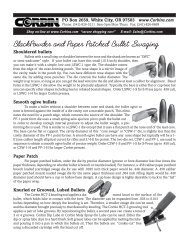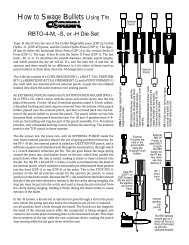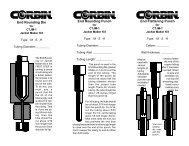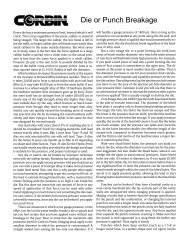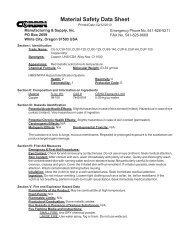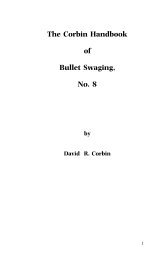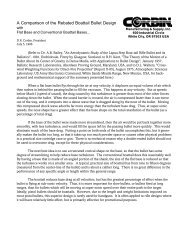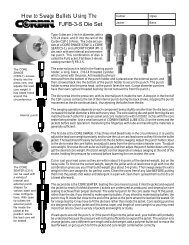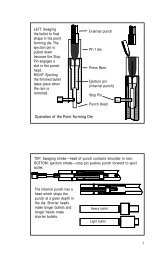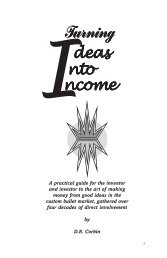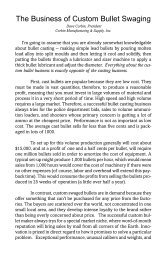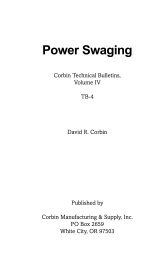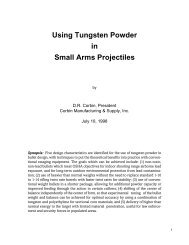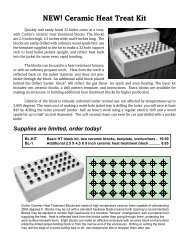HB-9 updated text (PDF) - Corbin Bullet Swaging
HB-9 updated text (PDF) - Corbin Bullet Swaging
HB-9 updated text (PDF) - Corbin Bullet Swaging
You also want an ePaper? Increase the reach of your titles
YUMPU automatically turns print PDFs into web optimized ePapers that Google loves.
There is no such thing as a single kind of die material called “carbide”,<br />
except in the minds of ad writers. When you heat any tool steel to a high<br />
enough temperature, some of the carbon in the material dissolves in the<br />
nearby iron, and forms a ferric carbide material which can be captured in<br />
the frozen matrix of the steel if the temperature is lowered quickly enough.<br />
The ferric carbide trapped in the steel mixture is primarily what gives<br />
the steel its hardness. The structure also has a matrix of iron and other<br />
elements, which form complex compounds that give the steel ductility,<br />
ability to remain hard at higher temperatures, and corrosion and shock<br />
resistance. All hardened steels have “carbide” in them: that’s what makes<br />
them hard.<br />
If you systematically reduced the amount of iron and increased the<br />
amount of carbon that dissolved in the iron that was left, you would wind<br />
up with a very hard, but also very brittle material. It might be almost<br />
“solid carbide” but it wouldn’t be very strong. By forming compounds of<br />
tungsten and other metals with carbon, the General Electric company<br />
(and others) developed commercially acceptable variations of “carbide”<br />
in a wide variety of grades. General Electric’s trade name of “Carboloy”<br />
was applied to some of these.<br />
The important thing to note is that there are variations that are nearly<br />
as soft as hardened tool steel, and others that are so brittle that they shatter<br />
like glass if force is applied incorrectly. Some carbide materials can<br />
handle high temperatures and some fracture when heated and cooled during<br />
use. Some make good tool bits, and some are only good for a thin<br />
coating on the surface of a hardened steel bit. Some are reasonable to<br />
machine accurately, and some cost a fortune to machine compared to<br />
making the same shape from a good tool steel.<br />
If you were to be faced with the decision of a material from which to<br />
build dies for a high speed punch press, working at 40 strokes per minute<br />
or more, and making several million bullets, then one of these grades of<br />
carbide material could give you higher temperature operation and thus<br />
longer life than a tool steel die. Because the harder materials are more<br />
abrasion resistant, you would be able to run the dies for a longer time<br />
before replacing them.<br />
They would still need to be lubricated: the idea that carbide dies need<br />
no lubrication is foolish. It is like saying that because your car engine<br />
might run 100,000 miles without changing the oil, you don’t need to<br />
change the oil. It might run 250,000 miles if you did!<br />
It is necessary to consider value to make a good decision about die<br />
materials. Value is the cost of the die amortized over the number of bullets<br />
you expect to make, considering the amount of wear which will take<br />
place before the bullets are no longer acceptable quality. It is somewhat<br />
29



